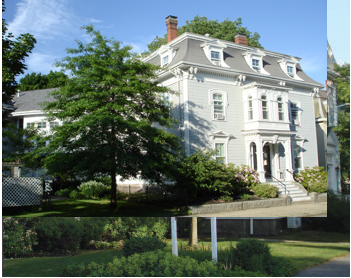Affordable Housing Leader Shares Practice-Based Lessons with #BUCPUA Students

On Thursday, November 3, Kristin Carlson, a Senior Project Manager with Harborlight Community Partners, clicked through images of empty lots transformed into beautiful, vibrant buildings. “Everyone knows there’s a need for affordable housing,” she said, as she pointed to projects her non-profit has worked on.
BU Adjunct Faculty member Lily Song , PhD, hosted Carlson for a lecture in her course, UA 503 Housing and Community Development. Students peered at overgrown parking lots and refurbished buildings as Carlson shared her experiences developing and managing affordable, multifamily housing projects.
Ruben Ceron (MET ’18) explained that his class often “talks about community integration issues in Boston,” and he was excited to learn more about problems facing the city of Boston. In the BU City Planning and Urban Affairs Program, several courses immediately support real-world practical applications addressing affordable housing developments, including UA 505 Real Estate Development, UA 510 Special Topics: Affordable Housing Financing, and UA 664 Planning and the Development Process.
UA 503 students were not the only ones attending – the lecture drew in Alexander M. Silberman (SMG ’17), who studies finance and real estate. “I’m interested in how the public and private sector work together,” he said. “Most of my experience is academic and I want to see the practical side of projects.”
Carlson dived into the practical aspects of affordable housing, describing applications for funding, feasibility studies, and design management. Students were very curious about funding sources for these housing developments.

“Where is the incentive for non-profits to get involved? Do they make a profit?” asked Tasha Davis (MET’18). Carlson explained the financial side of housing development, stating that a mixture of state money, federal money, locally raised money and tax credits are provided to fund these projects. Each deal also creates a developer fee of ten percent, which helps sustains the non-profit.
“Talking about this does beg the question on why I would even want to do this,” said Carlson as she laughed. “It sounds kind of crazy!”
On top of financial trials, non-profits also face challenges with industrial sites, where environmental issues may arise. Carlson presented a historic renovation of an old shoe factory, where lead and asbestos were discovered. She was not perturbed by this, however, and instead she passionately explained that “non-profits have a commitment to provide affordable housing, and sometimes we take on sites that are a bit more difficult.”
Students and future planners took copious notes about everything from how non-profits work, who they work with, the physical aspects of development, and guidelines to comply with. It is a long road to finishing a project, but Carlson explained that she is always deeply invested in where she works.
The knowledge Carlson imparted will be translated from the classroom and into real-world scenarios. Devin Weaver (CAS ’17) said he works at Health Leads in a pediatrics clinic, where people also approach him for housing assistance. He hopes to address the social detriments of health, specifically with housing, and he is eager to apply Carlson’s valuable insights at his own place of work.